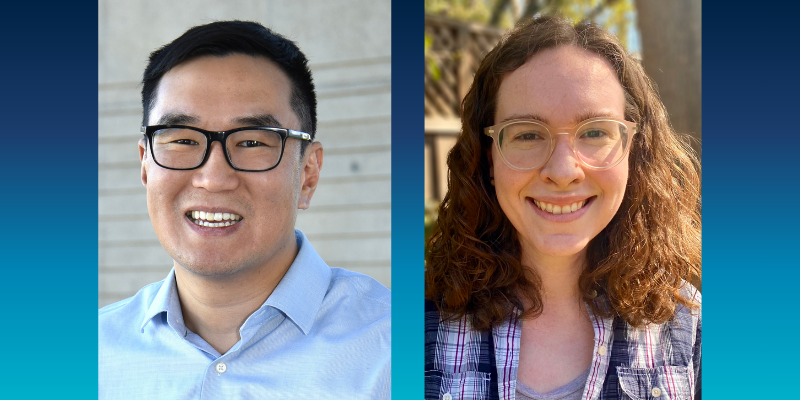
Irvine, Calif., July 2, 2025 — How do cells know which genes to activate, and when? For decades, scientists have puzzled over how distant parts of our DNA — sometimes millions of base pairs apart — can find and influence each other at exactly the right moment during development. A new study published in Nature from UC Irvine’s Charlie Dunlop School of Biological Sciences may finally have an answer.
The research, led by Assistant Professor Evgeny Kvon and graduate student Grace Bower and carried out in collaboration with researchers from Lawrence Berkeley National Laboratory and institutions in Spain and France, has uncovered a previously unknown DNA element that helps distant “enhancers” — stretches of DNA that turn genes on — communicate with their target genes across vast genomic distances. The team has named this new element a “Range Extender.”
Enhancers work like switches of gene activity, but scientists have long struggled to understand how they function across such vast genomic distances. While researchers have known that DNA folding by structural nuclear proteins can bring enhancers and genes closer together, this process alone doesn’t fully explain how long-range gene activation works. The missing piece, it turns out, may be the Range Extender.
“Our work tackles the longstanding question in gene regulation: how do enhancers activate genes over distances that can sometimes exceed millions of base pairs?” said Assistant Professor Evgeny Kvon, the study’s senior and corresponding author. “Although extensive research has focused on the role of 3D nuclear organization, it has become clear that other unknown factors also contribute. In this study, we identified one of the missing factors: a previously uncharacterized class of regulatory DNA elements called Range Extenders, which help enhancers activate their target genes. Without these elements, enhancers can only function at close distances.”
To test this, the Kvon lab used precision genetic tools to engineer mouse models in which various enhancers were relocated far from the gene. Normally, such enhancers failed to work, but when paired with a Range Extender, they suddenly succeeded in turning on the gene. In one dramatic example, an enhancer that typically works at ~71,000 base pairs was able to activate a gene over more than 840,000 base pairs when a Range Extender was added.
“The biggest challenge was ensuring that our discovery was not an artifact,” Kvon explained. “With any unexpected finding, the first question is always whether the observed phenomenon is due to alternative explanations. We had to conduct additional experiments to rule out these alternative explanations. The control experiments actually took longer to complete because we needed to create new genetically engineered animal models. The results of these experiments further supported our hypothesis on range extender elements.”
At the molecular level, Range Extenders contain short, repeating DNA sequences that appear to serve as docking sites for proteins that help form DNA loops, bringing faraway regions of the genome into close contact. The study also found that these sequences are enriched across the genome in other regions where long-range gene activation occurs, suggesting that Range Extenders may be a widespread and fundamental part of how gene regulation works.
The implications of this discovery could be far-reaching. Disruptions in long-range enhancer activity are linked to a wide range of human diseases, from birth defects to cancer. By identifying Range Extenders, researchers now have a new class of genomic elements to explore as potentially linked to human disease. The findings may also enhance the design of gene therapies and synthetic biology applications where precise control over gene activation is crucial.
“Our study raises several questions for future research,” Kvon added. “One is whether similar Range Extender elements operate in other cell types of the organism. The other concerns the nature of the molecular mechanism that enables the Range Extender to facilitate remote enhancer-promoter communication. We suspect that a specialized class of transcriptional regulatory proteins capable of facilitating DNA loops is involved.”
This discovery also highlights the vital importance of basic research and the federal NIH funding that supported it. Advancements like this, which lay the groundwork for future medical breakthroughs, are only possible through sustained investment in science that seeks to understand life at its most fundamental level.
The Kvon lab’s work doesn’t just solve a decades-old mystery; it opens the door to entirely new ways of thinking about how the genome is wired, and how we might one day rewire it to improve human health.
About the University of California, Irvine Charlie Dunlop School of Biological Sciences:
Recognized for its pioneering research and academic excellence, the Charlie Dunlop School of Biological Sciences plays a crucial role in the university’s status among the nation’s top 10 public universities, as ranked by U.S. News & World Report. It offers a broad spectrum of degree programs in the biological sciences, fostering innovation and preparing students for leadership in research, education, medicine and industry. Nestled in a globally acclaimed and economically vibrant community, the school contributes to the university’s impact as Orange County’s largest employer and a significant economic contributor. Through its commitment to exploring life’s complexities, the Dunlop School embodies the UC Irvine legacy of innovation and societal impact. For more on the Charlie Dunlop School of Biological Sciences, visit https://www.bio.uci.edu/.
